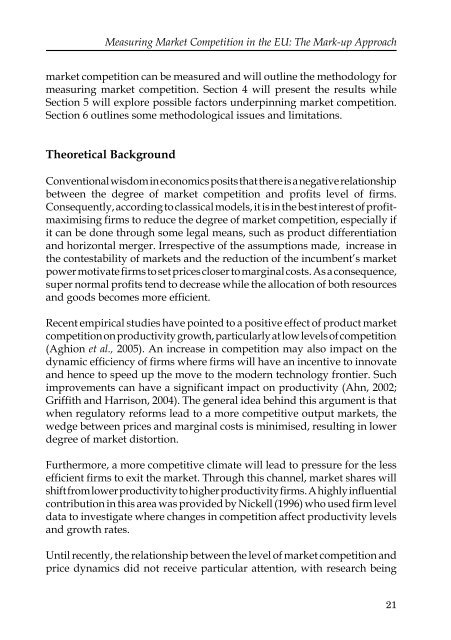MEASURING MARKET COMPETITION IN THE EU ... - Bank of Valletta
MEASURING MARKET COMPETITION IN THE EU ... - Bank of Valletta
MEASURING MARKET COMPETITION IN THE EU ... - Bank of Valletta
You also want an ePaper? Increase the reach of your titles
YUMPU automatically turns print PDFs into web optimized ePapers that Google loves.
Measuring Market Competition in the <strong>EU</strong>: The Mark-up Approach<br />
market competition can be measured and will outline the methodology for<br />
measuring market competition. Section 4 will present the results while<br />
Section 5 will explore possible factors underpinning market competition.<br />
Section 6 outlines some methodological issues and limitations.<br />
Theoretical Background<br />
Conventional wisdom in economics posits that there is a negative relationship<br />
between the degree <strong>of</strong> market competition and pr<strong>of</strong>its level <strong>of</strong> firms.<br />
Consequently, according to classical models, it is in the best interest <strong>of</strong> pr<strong>of</strong>itmaximising<br />
firms to reduce the degree <strong>of</strong> market competition, especially if<br />
it can be done through some legal means, such as product differentiation<br />
and horizontal merger. Irrespective <strong>of</strong> the assumptions made, increase in<br />
the contestability <strong>of</strong> markets and the reduction <strong>of</strong> the incumbent’s market<br />
power motivate firms to set prices closer to marginal costs. As a consequence,<br />
super normal pr<strong>of</strong>its tend to decrease while the allocation <strong>of</strong> both resources<br />
and goods becomes more efficient.<br />
Recent empirical studies have pointed to a positive effect <strong>of</strong> product market<br />
competition on productivity growth, particularly at low levels <strong>of</strong> competition<br />
(Aghion et al., 2005). An increase in competition may also impact on the<br />
dynamic efficiency <strong>of</strong> firms where firms will have an incentive to innovate<br />
and hence to speed up the move to the modern technology frontier. Such<br />
improvements can have a significant impact on productivity (Ahn, 2002;<br />
Griffith and Harrison, 2004). The general idea behind this argument is that<br />
when regulatory reforms lead to a more competitive output markets, the<br />
wedge between prices and marginal costs is minimised, resulting in lower<br />
degree <strong>of</strong> market distortion.<br />
Furthermore, a more competitive climate will lead to pressure for the less<br />
efficient firms to exit the market. Through this channel, market shares will<br />
shift from lower productivity to higher productivity firms. A highly influential<br />
contribution in this area was provided by Nickell (1996) who used firm level<br />
data to investigate where changes in competition affect productivity levels<br />
and growth rates.<br />
Until recently, the relationship between the level <strong>of</strong> market competition and<br />
price dynamics did not receive particular attention, with research being<br />
21







